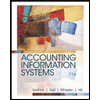
Intermediate Accounting
9th Edition
ISBN: 9781259722660
Author: J. David Spiceland, Mark W. Nelson, Wayne M Thomas
Publisher: McGraw-Hill Education
expand_more
expand_more
format_list_bulleted
Question
Chapter 1, Problem 1.12E
To determine
Financial accounting: Financial accounting is the process of recording, summarizing, and reporting all the transactions in the financial statement of the business over a period of time. The financial statement consists of the
To Identify: The accounting concept that is applied if you agree with the given statement and the accounting concept that is violated if you disagree with the given statement.
Expert Solution & Answer
Want to see the full answer?
Check out a sample textbook solution
Students have asked these similar questions
don't give me incorrect solution
I mistakenly submitted blurr image please comment i will write values.
please dont Solve with incorrect values otherwise unhelpful.
Can you help me solve this general accounting problem using the correct accounting process?
Chapter 1 Solutions
Intermediate Accounting
Ch. 1 - Prob. 1.1QCh. 1 - What is meant by the phrase efficient allocation...Ch. 1 - Identify two important variables to be considered...Ch. 1 - What must a company do in the long run to be able...Ch. 1 - Prob. 1.5QCh. 1 - Prob. 1.6QCh. 1 - Prob. 1.7QCh. 1 - Prob. 1.8QCh. 1 - Prob. 1.9QCh. 1 - Prob. 1.10Q
Ch. 1 - Prob. 1.11QCh. 1 - Prob. 1.12QCh. 1 - Prob. 1.13QCh. 1 - Prob. 1.14QCh. 1 - Prob. 1.15QCh. 1 - Explain what is meant by: The benefits of...Ch. 1 - Prob. 1.17QCh. 1 - Briefly define the financial accounting elements:...Ch. 1 - Prob. 1.19QCh. 1 - What is the going concern assumption?Ch. 1 - Prob. 1.21QCh. 1 - Prob. 1.22QCh. 1 - What are two advantages to basing the valuation of...Ch. 1 - Describe how revenue recognition relates to...Ch. 1 - What are the four different approaches to...Ch. 1 - In addition to the financial statement elements...Ch. 1 - Briefly describe the inputs that companies should...Ch. 1 - Prob. 1.28QCh. 1 - Prob. 1.29QCh. 1 - Prob. 1.30QCh. 1 - Prob. 1.31QCh. 1 - Prob. 1.32QCh. 1 - Accrual accounting LO12 Cash flows during the...Ch. 1 - Financial statement elements LO17 For each of the...Ch. 1 - Prob. 1.3BECh. 1 - Basic assumptions and principles LO17 through...Ch. 1 - Prob. 1.5BECh. 1 - Prob. 1.6BECh. 1 - Accrual accounting LO12 Listed below are several...Ch. 1 - Accrual accounting LO12 Listed below are several...Ch. 1 - Prob. 1.3ECh. 1 - Prob. 1.4ECh. 1 - Prob. 1.5ECh. 1 - Financial statement elements LO17 For each of the...Ch. 1 - Concepts; terminology; conceptual framework LO17...Ch. 1 - Prob. 1.8ECh. 1 - Prob. 1.9ECh. 1 - Prob. 1.10ECh. 1 - Basic assumptions and principles LO18, LO19...Ch. 1 - Prob. 1.12ECh. 1 - Prob. 1.13ECh. 1 - Prob. 1.14ECh. 1 - Prob. 1.15ECh. 1 - Prob. 1.1BYPCh. 1 - Research Case 12 Accessing SEC information through...Ch. 1 - Prob. 1.3BYPCh. 1 - Prob. 1.4BYPCh. 1 - Ethics Case 18 The auditors responsibility LO14...Ch. 1 - Prob. 1.9BYPCh. 1 - Judgment Case 110 GAAP, comparability, and the...Ch. 1 - Prob. 1.11BYPCh. 1 - Prob. 1.12BYPCh. 1 - Analysis Case 113 Expense recognition LO19...Ch. 1 - Prob. 1.14BYPCh. 1 - Real World Case 115 Elements; disclosures; The...Ch. 1 - Prob. 1.16BYPCh. 1 - Target Case LO19 Target Corporation prepares its...
Knowledge Booster
Similar questions
- On March 1, 20X1, your company,which uses Units-of-Production (UOP) Depreciation, purchases a machine for $300,000.arrow_forwardPlease provide the accurate answer to this general accounting problem using valid techniques.arrow_forwardI am searching for the right answer to this financial accounting question using proper techniques.arrow_forward
- Please explain the solution to this general accounting problem with accurate principles.arrow_forwardI am searching for the correct answer to this general accounting problem with proper accounting rules.arrow_forwardi will give unhelpful.blurr image please comment i will write values. please dont Solve with incorrect values otherwise unhelpful.arrow_forward
arrow_back_ios
SEE MORE QUESTIONS
arrow_forward_ios
Recommended textbooks for you
 Survey of Accounting (Accounting I)AccountingISBN:9781305961883Author:Carl WarrenPublisher:Cengage Learning
Survey of Accounting (Accounting I)AccountingISBN:9781305961883Author:Carl WarrenPublisher:Cengage Learning Intermediate Accounting: Reporting And AnalysisAccountingISBN:9781337788281Author:James M. Wahlen, Jefferson P. Jones, Donald PagachPublisher:Cengage Learning
Intermediate Accounting: Reporting And AnalysisAccountingISBN:9781337788281Author:James M. Wahlen, Jefferson P. Jones, Donald PagachPublisher:Cengage Learning Financial Accounting: The Impact on Decision Make...AccountingISBN:9781305654174Author:Gary A. Porter, Curtis L. NortonPublisher:Cengage Learning
Financial Accounting: The Impact on Decision Make...AccountingISBN:9781305654174Author:Gary A. Porter, Curtis L. NortonPublisher:Cengage Learning Auditing: A Risk Based-Approach (MindTap Course L...AccountingISBN:9781337619455Author:Karla M Johnstone, Audrey A. Gramling, Larry E. RittenbergPublisher:Cengage Learning
Auditing: A Risk Based-Approach (MindTap Course L...AccountingISBN:9781337619455Author:Karla M Johnstone, Audrey A. Gramling, Larry E. RittenbergPublisher:Cengage Learning Auditing: A Risk Based-Approach to Conducting a Q...AccountingISBN:9781305080577Author:Karla M Johnstone, Audrey A. Gramling, Larry E. RittenbergPublisher:South-Western College Pub
Auditing: A Risk Based-Approach to Conducting a Q...AccountingISBN:9781305080577Author:Karla M Johnstone, Audrey A. Gramling, Larry E. RittenbergPublisher:South-Western College Pub Accounting Information SystemsFinanceISBN:9781337552127Author:Ulric J. Gelinas, Richard B. Dull, Patrick Wheeler, Mary Callahan HillPublisher:Cengage Learning
Accounting Information SystemsFinanceISBN:9781337552127Author:Ulric J. Gelinas, Richard B. Dull, Patrick Wheeler, Mary Callahan HillPublisher:Cengage Learning

Survey of Accounting (Accounting I)
Accounting
ISBN:9781305961883
Author:Carl Warren
Publisher:Cengage Learning

Intermediate Accounting: Reporting And Analysis
Accounting
ISBN:9781337788281
Author:James M. Wahlen, Jefferson P. Jones, Donald Pagach
Publisher:Cengage Learning

Financial Accounting: The Impact on Decision Make...
Accounting
ISBN:9781305654174
Author:Gary A. Porter, Curtis L. Norton
Publisher:Cengage Learning

Auditing: A Risk Based-Approach (MindTap Course L...
Accounting
ISBN:9781337619455
Author:Karla M Johnstone, Audrey A. Gramling, Larry E. Rittenberg
Publisher:Cengage Learning

Auditing: A Risk Based-Approach to Conducting a Q...
Accounting
ISBN:9781305080577
Author:Karla M Johnstone, Audrey A. Gramling, Larry E. Rittenberg
Publisher:South-Western College Pub

Accounting Information Systems
Finance
ISBN:9781337552127
Author:Ulric J. Gelinas, Richard B. Dull, Patrick Wheeler, Mary Callahan Hill
Publisher:Cengage Learning